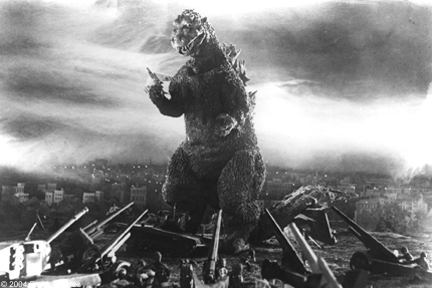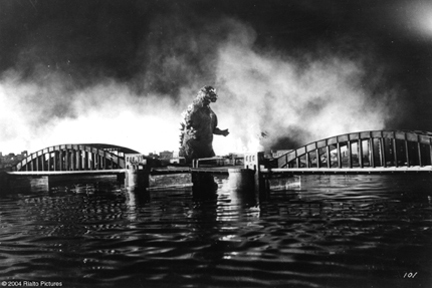I must’ve been about five years old the first time I saw Godzilla on screen. Sitting in a Chinese restaurant in Dillwyn, Virginia, waiting for a takeout order, I sat transfixed, staring at a small, staticky, CRT TV, as I saw him fighting other massive monsters, comically portrayed by actors in monster suits. As a result, in the decade before I saw another film featuring the giant beast, and even for a while after that, I viewed him as a sort of friendly giant, more humorous than terrifying, who may leave cities destroyed in his wake but hardly did so out of any particular malice towards mankind. I suppose it’s that ability to be anything to anyone that has given the character such a long-lasting appeal with new movies regularly being released for nearly six decades. From sci-fi epics to slapstick romps, destructive force of nature to benign protector, Godzilla has taken many forms, but in his first 1954 appearance, the story takes a much more serious and horrifying tone than has mostly been seen since. Before he was a loveable hero, Godzilla earned the name “King of the Monsters” as a potent metaphor for the destructive capabilities of the atomic bomb and American imperialism.

Awakened by hydrogen bomb testing, the ancient beast surfaces and begins attacking fishermen and small island villages before eventually reaching Tokyo and destroying everything in his wake. It’s a simple plot that could belong to many of the films in the Godzilla series, as well as many out of it, but the nuances and craft raise it to the legendary level it has achieved. Much like Jaws, another horror monster flick that would define generations of filmmaking to come, Godzilla hardly shows its beast. Rather than lessen the terror through dated special effects that never could’ve truly captured the horror of urban destruction , it’s a looming threat with fear of annihilation around the corner. This is particularly apt as a metaphor for the atomic bomb, which has continued to occupy the minds of people around the world as a constant threat despite not having been used in over three quarters of a century. For Japanese moviegoers watching Godzilla less than a decade after the bomb had been dropped twice on their country by the United States, the uneasy effect surely must have been even more pronounced.

When Godzilla is finally shown, he has the visage of a dinosaur struck with shrapnel, blending the ancient realities of war with the modern ways they are waged. Though the effects of a man in a lizard suit can be slightly jarring in opposition to the restraint shown by the rest of the film, it is no less horrific when the destruction begins as he moves slowly and deliberately as an unstoppable force of nature. Much like the war that had ended nine years earlier, once the beast had been awoken, it wouldn’t stop until everything in its way had been destroyed, taking no heed of the lives of those hundreds of feet beneath it. It’s a depiction that leaves no one blameless, asserting that the scourge of war will always cause more destruction through endless bouts of retaliation. Even in the end, when a selfless scientist decides to sacrifice himself rather than let the weapon of mass destruction capable of defeating Godzilla ever be used again, there is a discussion that borders on certainty about how Godzilla will rise again with continued use of nuclear weapons. Though Godzilla has been through various rounds of rehabilitation into anti-hero or back to villain (often paralleling changes in relations between the United States and Japan through the earlier years of the character), his first incarnation is the truest expression of the beast and its Cold War era fear of nuclear war continues to be impactful today, even as modern interpretations are more likely to feature fights with large monkeys.


0 comments on “Godzilla – From Villain to Hero and Back Again”